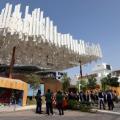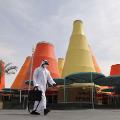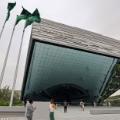(CNN)For the past six months, Dubai's World Expo has been taking place on 1,083 acres of reclaimed desert. After opening a year late, delayed by the Covid pandemic, Expo 2020 Dubai received more than more than 23 million visits, accommodated 192 participating countries, and hosted performances from the likes of Alicia Keys and Jason Derulo, and visits from world leaders such as the Crown Prince of Saudi Arabia, and French president Emmanuel Macron.
The event came to a close on March 31 with a display from the United Arab Emirates' Air Force's aerobatics team, and performances by Christina Aguilera, Norah Jones and Yo-Yo Ma. But now the party has wrapped up and the guests have made their final departure, will the site become a $7 billion "white elephant" -- an unwanted space that becomes a burden on the city?
A legacy site
Expo 2020 organizers say they planned for the legacy of the space from the outset, with 80% of the infrastructure scheduled to transition into District 2020, a mixed-use urban community, described as a "human-centric smart city."
"It's a full, comprehensive city," says Ahmed Al Khatib, chief development and delivery officer for the Expo 2020 site. The space includes homes, offices, leisure facilities, exercise grounds, a mall, and a metro station. According to Al Khatib, District 2020 will also be the largest city in the world to be fully covered by a 5G-enabled network.
"Every corner you walk to, there is a different attraction," he explains. "The parks, the landscaping, the trees -- the entire thing is designed on human needs."
The idea is for all amenities to be accessible to residents on foot in 15 minutes or less -- "Like an old traditional city," says Dina Storey, director of sustainability operations at Expo 2020.
There will be 10 kilometers of cycle tracks, 5km of jogging paths and a 4km autonomous vehicle public transit route. The site will retain 123 of the Expo structures and buildings, from the dominating wings of the UAE pavilion, designed by Spanish architect Santiago Calatrava, to the huge glass and steel façade of the Al Wasl Plaza.
In total, 260,000 square-meters of repurposed Expo buildings will provide homes and offices for up to 145,000 people.
A green city
Despite being built on a desert site, organizers say District 2020 will include 45,000 square meters of green space and parks filled with local native species, such as drought-tolerant Ghaf trees and Jasmine bushes. The buildings are also designed with the environment in mind, and each is fitted with solar panels. The Sustainability Pavilion, designed by British Architecture firm Grimshaw, is a showpiece of Expo's eco-friendly vision.
The pavilion is partially submerged, which keeps it cool, and has a 440-feet-wide steel canopy covered with over 1,000 solar panels. The building can generate up to 4 gigawatt hours of electricity a year — enough to power about 370 average homes — from the solar panels on the canopy and on the 18 "Energy Trees" around the pavilion.
In the transition to District 2020 it will become the Terra Children and Science Center, a museum and educational facility demonstrating the smart and sustainable capabilities of the site.
According to Storey, District 2020 will also be the first WELL Certified community in the region -- a standard that evaluates the impact of buildings on health and wellness. She says that to qualify, "there has to be vegan spaces, organic spaces for eating, and it really focuses on the wellbeing of the people that live here, the animals, and the biodiversity of the space itself."
'You need to have a plan in place'
With previous World Expos, many sites have become "white elephants," says Tim van Vrijaldenhoven, an independent expert in urban planning, and author of "Reaching Beyond the Gold: The Impact of Global Events on Urban Development." In those cases, the space hasn't been needed by the city, and so hasn't been incorporated into wider urban development. Dubai is different, Vrijaldenhoven says, because it's a rapidly growing city and the site is being integrated into an urban master plan.
He adds that it's vital that Dubai moves ahead with the development of District 2020 quickly, before people lose interest. "After the event, with every Expo, the momentum is gone," he says. "You need to immediately have a plan in place for transformation."
Vrijaldenhoven questions the feasibility of making a city pedestrian-friendly in a location where temperatures often reach 50 degrees Celsius, and adds that sites disconnected from the rest of a city, risk becoming "end of the line" locations. "Unless it's integrated into a network, with a strategically good location, it's difficult for people to make the decision to start living there," he explains.
But he's generally impressed with the plans. "I think that this is finally a right answer to how to deal with the legacy of Expos and not turning into white elephants," he says.
People and businesses will be able to move onto the Expo site as of October this year and companies including Siemens and Terminus have already secured their spots. The UK and the UAE plan to partner to open a hydrogen innovation center on site, with the goal of speeding up decarbonization in aviation and shipping. And Italy's imposing pavilion will transform into a center for the preservation of archaeological artifacts and art recovered from war zones.
"It's a lot of education, a lot of innovation, a lot of entertainment as well," says Al Khatib. "In 10 years, I imagine it's a very busy site."
"now" - Google News
April 02, 2022 at 03:25PM
https://ift.tt/3qz4Y8N
Now Expo is over, will District 2020 leave a positive legacy for Dubai? - CNN
"now" - Google News
https://ift.tt/G3CP9KQ
Bagikan Berita Ini














































0 Response to "Now Expo is over, will District 2020 leave a positive legacy for Dubai? - CNN"
Post a Comment